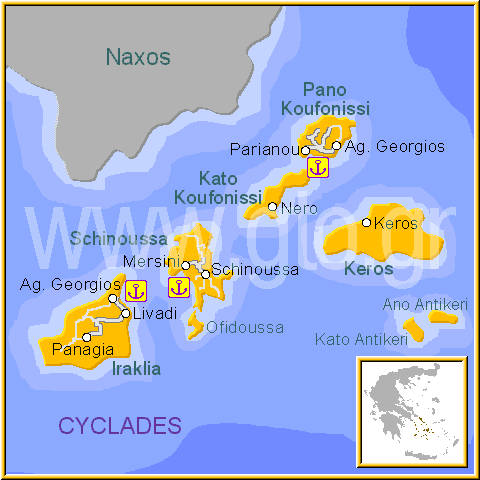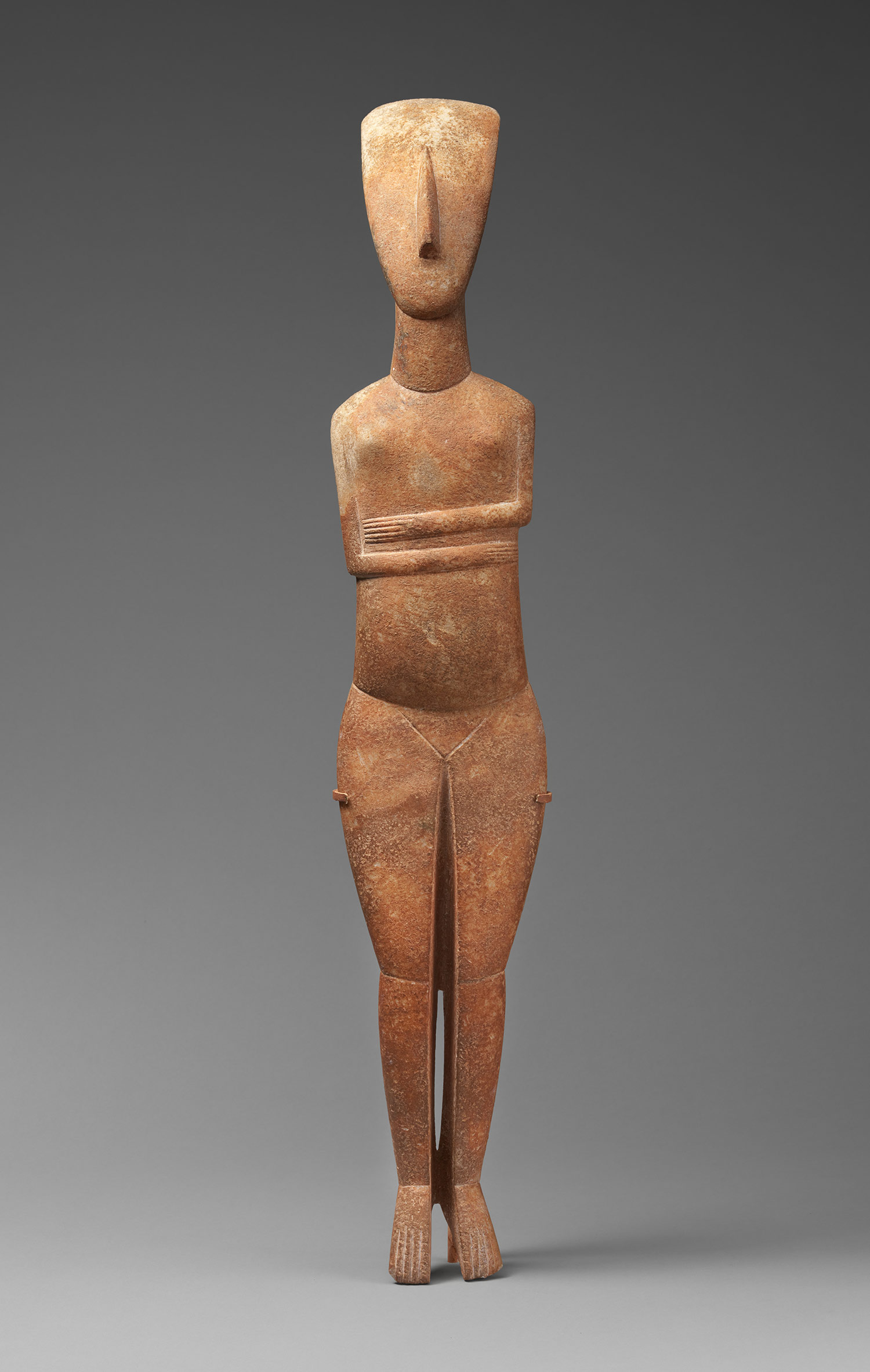კიკლადები -
საბერძნეთში კუნძულ კეროსზე (კიკლადები) ბრიტანელმა და ბერძენმა მეცნიერებმა აღმოაჩინეს უძველესი სარიტუალო ცენტრი რომლის ასაკია 4500 წელი! ამ ადგილს კუნძულ კეროსზე - კავოსი ეწოდება.
არქეოლოგიური გათხრები განახლდა 20 წლიანი პაუზის შემდეგ, ჯერ კიდევ 1960 წლებში აქ პირველი გათხრები აწარმოეს, მაგრამ მძარცველების აქტიური საქმიანობის გამო ეს გათხრები შეწყდა, რადგან ცნობილი კიკლადური ქანდაკეკების ბუმის გამო შესაძლო იყო ორიგინალი ვერ გაერჩიათ ყალბისგან. ახალ კი ეს გათხრები კვლავ განახლდა. ამ კუნძულზე იპოვეს ხელუხლებელი არქეოლოგიური მასალა. საინტერესო ისაა რომ იპოვეს კერამიკის და მარმარილოს დამტვრეული ფრაგმენტები. ამ უცნაურიბას "კეროსის საიდუმლო ეწოდა" - ანუ ამზადებდნენ კერამიკის ნაკეთობებს მერე ამტვრევდნენ მათ და ისინი ფრაგმენტების სახით ჩამოჰქონდათ კუნძულ კეროსზე. ვერავის ხსნიდა იმას თუ რატომ ამტვრევდნენ კერამიკულ ნაკეთობებს.
არქეოლოგებმა დაადგინეს, რომ ნატეხები ჩამოჵქონდათ აქ სხვა კუნძულებიდან - ნაკსოსის და სიროსიდან - და ამ ადგილას ატარებდნენ გარკვეულ რიტუალებს და შემდეგ ამ ნატეხებს მარხავდნენ მიწაში. ანუ კეროსი იყო ეგეოსური რაგიონის უძველესი სარიტუალო ცენტრი.

საინტერესო ისაა რომ ამ რეგიონში პოულობდნენ უძველესი კულტურის ფიგურებს - ე.წ. კიკლადურ ქანდაკებებს. რა ხალხი ცხოვრობდა მაშინ კიკლადებში - უცნობია.


ეს საკმაოდ საინტერესო ფიგურებია დამახასიათებელ პოზაში - ხელები დაწყობილია გულმკერდზე და სახე დამახასიათებელია - საინტერესო ისაა, რომ ეს ფიგურები რაღაცით ჰგვანან კუნძულ პასხის კერპებს.
http://www.historicart.se/HA_Butiksortimen...isk%20huvud.jpg
18" high. Figure of lyre player, ca. 2600, from Keros, 9" high.
კიკლადები ეს არის კუნძულთა არქიპელაგი ეგეოსის ზღვის სამხრეთით კუნძულ დელოსის გარშემო - По-гречески "Kyklades" - "лежащие крУгом". - ანუ ითარგმნება, როგორც კუნძულები ირგვლივ. (იგულისხმებოდა აპოლონის ტაძარი კუნძულ დელოსზე და მის გარშემო განლაგებული კუნძულები.
დღეს ეს კუნძულები მხოლოდ კლდეებისგან შედგებიან, მაგრამ ოდესღაც ისინი დაფარული იყო ტყეებით. ამ არქიპელაგის ყველაზე დიდი კუნძულებია - ნაკსოსი, პაროსი, ანდროსი, ტენოსი. - ისინი დასახლებული იყვნენე იონიელებით. მალოსი, თერა (სანტორინი) დასახლებული იყო დორიელებით, ნაკსოსზე იყო მრავლად მარმარილო, მელოსზე ობსიდიანი, კეოსზე განსაკუთრებული წითელი თიხა - красного глинистого железняка.
მაგრამ ეს ყველაფერი იყო 2-1000 წლის წინ ჩვ წ/აღმდე - ხოლო რა ხდებდა კიკლადებზე 2000-3500 წლებში ჩვ/წ/აღმდე - ეს რჩება თანამდეროვე არქეოლოგიის ერთ ერთ საიდუმლოდ. ამ კულტურას ეწოდა კიკლადური კულტურა - ნაპოვნია უცნაური ქანდაკებები - პატარა ფიგურები დამახასიათებელ პოზაში - ეს კულტურა იყო გიგანტური პირამიდების მშენებლობის თანამედროვე და ვინ იყო ეს ხალხი - დღეს ძნელი სათქმელია.
კიკლადურ კულტურას არ ქჰონდა დამწერლობამაგრამ ჰქონდათ საოცრად კარგად განვითარებული კერამიკული ხელოვნება. ნაპოვნია 20 000მდე კიკლადური ნივთი

9" high. Head of statue, ca. 2700-2400
http://www.britishmuseum.org/explore/galle...ic_islands.aspx
Early Bronze Age, around 2800 BC
From the island of Amorgos, the Cyclades, Aegean Sea
Throughout the Early Bronze Age in the Cyclades (approximately the third millennium BC) marble figurines were produced in two basic types: schematic and naturalistic. Schematic types, like this example, are most common in the earliest period of figurine production, though they continued to be made in parallel to the naturalistic examples.
This figure, with its characteristic outline, belongs to the so-called 'violin' type. Many 'violin' figures are completely plain, but in this piece the addition of breasts, arms and the pubic triangle makes the relationship to the human body more obvious. The head is simply an elongated prong, a very common form among the schematic figurines. The legs are not apparent at all. There are many seated or squatting female figures among the Neolithic predecessors to this type, and they frequently have legs that are diminutive or tucked away completely.
J.L. Fitton, Cycladic art, 2nd ed. (London, The British Museum Press, 1999)

პირველად ეს ნივთები - უცნაური კერპები შეამჩნიეს მე-19 საუკუნის დასაწყისში, ხოლო პირველი არქეოლოგიური გათხრები დაიწყო 1880 წელს - ჯეიმს თეოდორ ბენტის ხელმძღვანელობით - რამაც დაადასტურა წინაისტორიულ პერიოდში დიდი კულტურის არსებობა კიკლადებზე.

Middle Bronze Age, about 1800-1550 BC
Probably from the island of Mílos, the Cyclades, Aegean Sea
იპოვეს საოცარი კერამიკული ნივთები, თასები, ქანდაკებები, და ბრინჯაოს სამეურნეო ნივთები




განსაკუთრებით შთამბეჭდავი იყო ე/წ/ კიკლადური ფიგურები რომელთა ზომა მერყეობდა 5 სმ-დან ადამიანის ზომამდე.
ამ კერპებს ჰქონდათ საინტერესო პოზები და გამოსახვის საინტერეო სტილი, რომელიც საოცრად თანამედროვეა და პიკასოს ნამუშევრებს გვაგონებს. ამქანდაკებებზე არის დაზიანების და შეკეთების კვალი, საიდანაც დაასვნეს, რომ მათ რაღაც რიტუალებისათვის იყენებდნენ. არაა გამორიცხული ეს ფიგურები დასაკრძალი რიტუალების ნივთი იყო, რადგან მათ ძველად მარხავდნენ კიდეც. ზოგი მათგანი ქალს გამოსახავდა - შესაძლოა ეს დედა-ღვთაების კულტის გამოხატულებაც კი იყო.


Steatopygous female figure, ca. 4500–4000 B.C.; Final Neolithic
Cycladic
Marble; H. 8 5/16 in. (21.5 cm)
Bequest of Walter C. Baker, 1971 (1972.118.104)

Group of arsenical copper tools
Heavy-duty carpenters' tools
Early Bronze Age, about 2700-2200 BC
From the island of Naxos, the Cyclades, Aegean Sea
http://www.metmuseum.org/toah/ht/02/eus/ht02eus.htmBetween 8000 and 2000 B.C., southern Europe witnesses a gradual but momentous change in living patterns as wandering groups of hunter-gatherers give way to sedentary agricultural and pastoral communities. This change fosters the need for greater cooperation both within and between communities. The presence at early village sites of imported materials such as obsidian implies the development of seafaring and trade.
ca. 8000 B.C. Cave art is particularly well represented in the southeast coastal region of Spain. These paintings give clear indications of dress and weapons, notably bows and arrows, and of dancing and hunting activities.
• ca. 7250–6000 B.C. Franchthi Cave in the Argolid, Greece, attests to the earliest deliberate burials in Greece.
• ca. 7000 B.C. Evidence of emmer and einkorn wheat, barley, sheep, goats, and pigs suggests that a food-producing economy is adopted in Greece and the Aegean. Pits, postholes, and foundations at Sesklo indicate simple huts. The presence of Melian obsidian implies seafaring.
• ca. 6000–4500 B.C. Archaeological evidence from various sites on the Iberian Peninsula suggests the domestication of plants and animals. The extreme rarity of permanent settlements suggests a relatively mobile population.
• ca. 5700–5300 B.C. The first "Megaron house," a rectangular, freestanding structure with a central hearth, is built at Sesklo in central Greece. The lack of fortifications and the manufacture of elegant painted pottery during this period suggest a peaceful and flourishing agricultural society.
• ca. 5300–3200 B.C. Metallurgical remains from various sites on mainland Greece suggest some relationship between these communities and the rest of southeastern Europe.
• ca. 4500 B.C. The earliest farming takes place on the Iberian Peninsula as established by grains of cultivated barley found in a cave site near Alicante, Spain. Sedentary agriculture fosters cooperation among communities and the formation of villages consisting of animal pens and huts made from branches.
• ca. 4500–3700 B.C. Circular village compounds are built in the area of the Tavoliere plain in northern Apulia. The presence of obsidian from Lipari implies some trade and seafaring. There is a general diffusion of farming communities throughout the Italian peninsula.
• ca. 4500–3250 B.C. The rarity of open-air settlements suggests the continuation of a relatively mobile society. Collective burials in Iberia are found in natural caves (particularly in Catalonia) and in a variety of artificial chambers. In Portugal, the construction of megalithic tombs is well under way. The earliest known on the Iberian Peninsula are built at Poco de Gatiera and Gorgines, both in present-day Portugal, around 4200–4000 B.C.
• ca. 4100–3500 B.C. Single burials in open-air pits occur at Toll in Catalonia. Grave lots show affinities to the Chassey of southern France.
• ca. 3700–3000 B.C. Remains of settlements at Ripoli on the terrace of the Vibrata valley show foundations for substantial grain-storage silos, implying an abundance of food production.
• ca. 3400 B.C. The earliest evidence of fortifications in Greece occur at Dimini. Spacious buildings on the rocky summit suggest a rise of some sort of centralized authority at this time.
• ca. 3250–2250 B.C. The most characteristic physical features of the Chalcolithic period in Spain are megalithic stone burial mounds such as those at Antequera in the south.
• ca. 3250–2250 B.C. Central Portugal and southeast Spain have an abundance of deeply stratified, often fortified, settlements. The long-term occupation of these villages is based on intensive systems of agriculture. There is evidence for distinctions within and between communities in terms of social status and rank.
• ca. 3200–2000 B.C. The exploitation of the olive and the vine together with the traditional cereals, as well as the rapid expansion of metallurgy, play a major role in the earliest urbanization in the Aegean. The existence of many settlements and burial grounds on the Cycladic Islands and Crete suggest flourishing economies.
• ca. 3000–2000 B.C. A marble industry flourishes in the Cyclades, with notable quarries in Naxos and Paros. Cycladic sculptors produce uncompromisingly abstract sculptures that have been found mostly in burial contexts.
• ca. 3000–2000 B.C. Evidence for the so-called "Almerían culture" is found throughout the southeastern part of the Iberian Peninsula. The preference is for open-air villages and simple chambered tombs.
• ca. 3000–1100 B.C. Minoan civilization flourishes on Crete. It reaches its apogee between 1700 and 1100 B.C. with the establishment of centers, known as palaces, that concentrate political and economic power, as well as artistic activity, and may serve as centers for the redistribution of agricultural commodities. The Minoans employ two scripts: a hieroglyphic script whose source of inspiration is probably Egypt, and a linear script, Linear A, perhaps inspired by the cuneiform of the eastern Mediterranean.
• ca. 2800 B.C. Evidence for the Lagozza culture in lake-side settlements set on pilings is found in the Po River valley in northern Italy. There is some evidence of wildfowling, weaving, and spinning. The Gaudo culture settles in Campania and its inhabitants build chamber tombs with multiple successive inhumations; nothing is known of their habitation sites.


